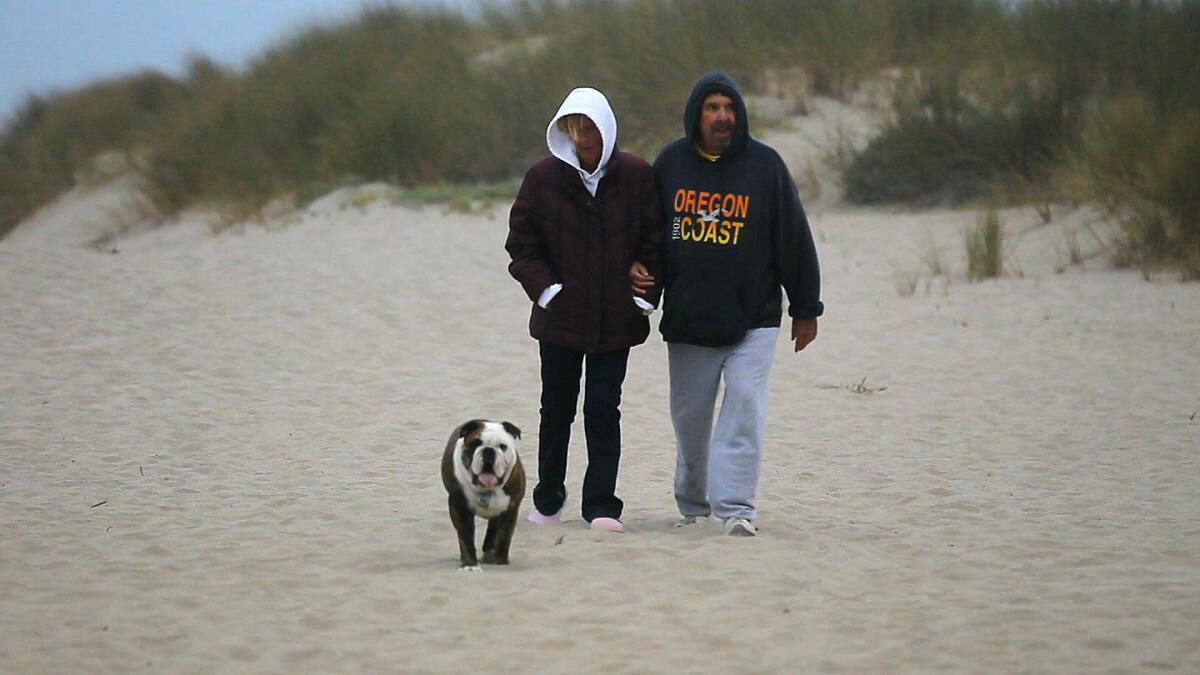Little-known brain disease rips apart lives of victim, loved ones

“I guess I got something wrong in my head,” is all that Stu Bryant can say when asked about his brain disease. (Robert Gauthier / Los Angeles Times)
More than a year after the diagnosis, Maureen Bryant had grown accustomed to making excuses for her husband.
When Stu stood behind a tattooed woman in line at Panda Express, and said loudly, “Wow, that’s a lot of tattoos,” Moe stepped between him and the woman and apologized.
When he repeatedly wandered into the house that was being built down the street — despite the “No Trespassing” sign and the fence — she explained to the owner that he was just curious.
Possibly the most embarrassing episode occurred when they were coming home from dinner, and she dashed into a mini-mart at a marina in Oxnard to buy milk.
“Do you know that man?” the owner said, seeing Stu in the car. “He’s been stealing from me.”
Moe remembers being baffled.

Muffins and cheesecake, the owner said, showing her photos from the store’s video camera. “But I can’t catch him. He drives away in the golf cart too fast.”
Moe offered to pay for what Stu had taken. “He has no control over what he does,” she said to police when they arrived.
Sometimes she will say that he has a brain tumor. It’s easier than saying frontotemporal dementia and having to describe how the disease has stripped away his self-restraint. Stu is no longer aware of how to behave in the company of others, and like an unknowing child, will blurt out the first thing that comes to mind or will act without considering the consequences.
Moe realizes that this is difficult to understand. Being rude or disrespectful seems like a deliberate choice, and Stu, 60, has a quick smile and an easy laugh. It’s easy for people to write him off as inconsiderate and self-centered.
This is what Moe and her daughters, Katy and Jessica, did before they discovered how sick he was.
::
Once called Pick’s disease and now FTD, frontotemporal dementia hides its symptoms well. Like Alzheimer’s, it is the result of the degeneration of neurons caused by an abnormal accumulation of proteins in the brain.
In early stages, Alzheimer’s affects predominantly the hippocampus in the inner part of the brain, where memories are formed, and FTD affects the frontal and temporal lobes, above and behind the eyes, where social emotions are formed. Alzheimer’s patients sense a fuzziness in their thinking — a word misplaced, a confusion between the past and present — and realize their errors. Most patients with FTD have no such insight into their disease.
Jessica, 22, first noticed her father becoming more selfish and temperamental when they lived in Sacramento. He doted upon his daughters and would do anything for them, but then that seemed to stop. Where once he let Jessica choose what to watch on TV, now he held on to the remote and got angry if she changed the channel.
The tragedy of FTD, according to Mario Mendez, the UCLA neurologist treating Stu, is its elusive diagnosis. The presence of the disease can be confirmed only through an autopsy, and Mendez reached his conclusion about Stu based on specific behaviors and brain scans.
The disease begins with a change in personality that’s often seen as volitional. Introverts become extroverts. Once-agreeable employees act rude. Formerly faithful spouses have affairs, and while they acknowledge their transgressions, they are unable to appreciate the implications.
Some end up institutionalized because their behavior looks like mental illness. Some are incarcerated when they break the law. A diagnosis of FTD led to reduced charges against a New York City physician who cut his initials into the stomach of a patient, and what could have been as many as 25 years in prison ended up as five years’ probation.
Researchers believe that between 30,000 and 50,000 people in the United States have FTD. There is no cure, and the disease leads to death, often within eight years, either from accidents or secondary infections.
When Stu began acting differently in 2007, bickering with Jessica, Moe didn’t think anything of it. She and Stu had been married more than 25 years. She figured relationships change.
::
He was the dreamer, she the pragmatic one. She was a consultant for a healthcare company, and he was a private golf coach and a car salesman. But his real passion was coaching baseball. According to Jerry Weinstein — who was head coach in the early 1980s at Sacramento City College, where Stu worked — Stu was known for his caustic wit and demanding practices. The players trusted him, Weinstein said.
Moe and Stu had moved to Sacramento from Los Angeles in 1992. His father had just died, and he thought he should be near his mother. But a decade later, when she was in her 80s, he suddenly stopped wanting to see her.
When Moe asked why, he couldn’t say, and after his mother died, he became more withdrawn and stubborn. They saw a counselor and decided that leaving Sacramento might help them get over their problems.
Moe found a rental in Oxnard on the strand between the harbor and the ocean. With so many golf courses in the area, she thought, Stu would be able to find a job and play as much as he liked. He worked for a few months and then stopped. They fought, and one day, almost a year after moving to the beach, she came home to find him packing a U-Haul.
He said he was moving back to Sacramento and had no explanation other than “because this is what I’m doing.” Moe, 52, still remembers how empty his expression was that May afternoon in 2010. Family members thought he was having an affair.
He rented a one-bedroom apartment. A family friend, Ed Modeste, visited him and found the place nearly empty: a TV, a chair, not much more. Stu rarely contacted the family.
Divorce seemed inevitable. Then one night Katy, 26, called Moe in tears.
She was living in the Monterey area and had invited her father for the weekend. She and Stu went on a bike ride in the hills above Ft. Ord, and he disappeared, showing up two hours later, hardly concerned that they had become separated. The next day at the U.S. Open at Pebble Beach — her Father’s Day treat for him — he couldn’t stand still or be quiet, and she thought they’d be kicked out.
She insisted that her mother take him to the family doctor; she had never seen her father act this way. Moe flew to Sacramento, and after Stu underwent an MRI, she felt her life shifting again.
Stu, the doctor told her, is in no position to live by himself. You can either proceed with the separation or you can set your feelings aside and treat this like a medical disease.
Moe wasn’t ready to forgive Stu any more than she was prepared to be his caretaker or his widow. But she couldn’t leave him on his own.
::
Stu didn’t know that he had hurt his family; he had lost his capacity to care. Moe had to explain to friends and family why she took him back after his three-month absence. Most had never heard of FTD; some thought it a weak excuse for a mid-life crisis.
Under the sway of the disease, impulses in Stu’s brain went unchecked. He logged 30 miles on his bike in the course of three daily rides and he became agitated if he did not get to the golf course each day. He was in constant motion, snapping his fingers and tapping his toes. He snacked compulsively, especially when Moe wasn’t around to stop him.
Reading about the disease, Moe came across the name of Mario Mendez, a professor of neurology and psychiatry at UCLA and the director of the neurobehavior unit at the West Los Angeles Veterans Affairs hospital.
Mendez and Jill Shapira, a nurse practitioner, see FTD patients on Wednesdays, and Moe made their first appointment for Sept. 8, 2010. Mendez and Shapira reassured Moe that with medications and guidance, Stu’s more uninhibited, repetitive behaviors could be suppressed.
Moe and Stu also agreed to take part in a study of the disease. Because FTD makes empathy, embarrassment, guilt and shame all the more conspicuous for their absence, Mendez is investigating how social emotions arise out of the physiology of the brain.
Mendez and Shapira ran a number of tests on Stu designed to isolate different parts of the frontal and temporal lobes. Some were written; some were conducted in conversation, and in one instance, Stu looked at photographs of flowers, mountains, road kill and starving children as monitors captured his skin temperature and heart rate.
“What does it mean that people who live in glass houses shouldn’t throw stones?” Mendez asked Stu during a follow-up appointment.
“You’d break the glass,” Stu said.
Just as he is incapable of interpreting this saying or engaging in abstract thinking, he is similarly unable to decipher social situations and know why insulting a stranger with tattoos, trespassing on private property or stealing is wrong.
In November, Moe and Stu arrived at UCLA for another MRI. Moe hoped to see how far the disease had progressed. Stu lay down inside the huge machine. When the technician asked if he wanted to listen to music, he asked for the Rolling Stones, one of his favorite bands.
“Let It Bleed” began to play.
::
The Bryants’ living room fronts the dunes. The Channel Islands float on the horizon, and above the garage hangs a sign that reads “Lazy Days.”
Moe gives Stu daily tasks — walking the dogs, cleaning windows, feeding the tortoise, vacuuming — to keep him occupied so he won’t wander in and out of the house or search for food that she’s hidden. She feigns forgetfulness when they talk, so he will exercise his memory. She plans special outings, like a whale-watching trip a few weeks ago.
The recent MRI, according to Mendez, showed only minute changes in Stu’s brain over the last year, but Moe is hardly reassured.
Stu recently took Katy’s keys and disappeared in her car without telling anyone. On one of his bike rides, he was hit by a car, and though he had a gash on his leg, he worried only about his ruined bike. At dinner the other night, he started to choke, a sign that he’s losing control of his chewing and swallowing.
In time, Moe expects him to become more sedentary and apathetic, and she worries how this will change their lives. For now, though, she stays vigilant, letting down her guard only at night when she lies in bed listening to the distant, rolling surf and to Stu breathing in his sleep beside her.
More to Read
Start your day right
Sign up for Essential California for news, features and recommendations from the L.A. Times and beyond in your inbox six days a week.
You may occasionally receive promotional content from the Los Angeles Times.







